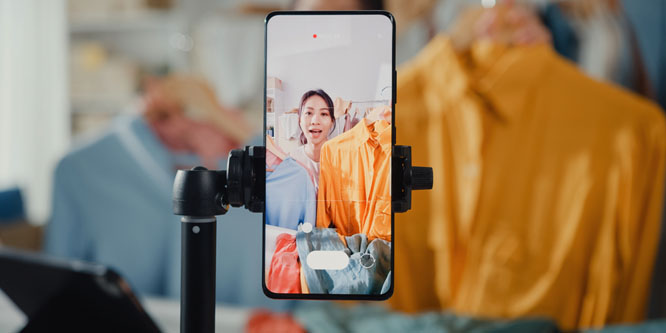
Photo: Getty Images/Phiromya Intawongpan
September 20, 2022
Is livestream commerce about to break through?
Knowledge at Wharton staff
Presented here for discussion is a summary of a current article published with permission from Knowledge at Wharton, the online research and business analysis journal of the Wharton School of the University of Pennsylvania.
In an article for Harvard Business Review, “Selling on TikTok and Taobao,” Wharton marketing professor Thomas Robertson argues that livestream commerce is fast becoming the medium of choice for online shopping, but technology and marketing’s learning curve is holding back adoption in the U.S.
A core reason livestream commerce is maturing faster in China than in the U.S. is because Alibaba’s Taobao platform provides the ability make a purchase without leaving the stream. According to iResearch China, livestream commerce is expected to account for between 20 percent to 25 percent of China’s online sales by 2023, up from 10 percent in 2020.
“We don’t have an integrated app at the present time in the U.S.” said Prof. Robertson said in an interview with Knowledge at Wharton. “It’s moving in that direction.”
In the U.S., the favored format among social-media platforms seems to be TikTok whereas other platforms are being retrofitted to accommodate video.
There’s also a learning curve involved. Prof. Robertson said, “You have to choose the right platform, and you have to choose the right influencer. Is it someone with a following, or a more specialized influencer who knows more about a specific category, such as cosmetics or a technology good?”
Nonetheless, Prof. Robertson expects rapid growth for livestream commerce as e-commerce shifts from a “solitary experience” supported by text and imagery to a communal one embracing real-time videos led by influencers.
He said, “People are relating to one another, so you’re not alone. You may not know the people shopping with you, but you identify with them because you have similar interests. Other people buy, and you feel it’s legitimate and will do it as well. There’s a social pressure of sorts in livestream commerce events.”
His advice for brands exploring livestream commerce includes starting early.
“This is part of your arsenal,” said Prof. Robertson. “You have to integrate livestream commerce with your other marketing strategies and tactics. How does it fit in? I recognize that, as I talk to some of these major brands, it took more than one experience to get it right.”
Discussion Questions
DISCUSSION QUESTIONS: Do you see livestream shopping becoming a more significant driver of e-commerce in the U.S. over the next five years? What advice would you have for brands thinking about jumping into livestream shopping?
Poll
BrainTrust
Cathy Hotka
Principal, Cathy Hotka & Associates
Brandon Rael
Strategy & Operations Transformation Leader
Recent Discussions







Livestream shopping haș grown and continues to grow in the U.S., but it is nowhere near as dominant as in China. Lower production quality, inferior technology and a less strategic approach by retailers are all reasons why livestream is held back in the U.S. That said, even if these improvements are made there doesn’t seem to be quite the same consumer appetite for it in the U.S. as in China – which we also must remember is still subject to various COVID-19 restrictions which inhibit in-person shopping in some regions.
The original livestream shopping was QVC. Is that who you want to be?
In a word, YES! Livestream has actually been one of the most powerful selling techniques in the U.S. for years — think QVC and DRTV/As Seen On TV infomercials. Livestream is just a short product demo at its core. I would caution marketers to not use this as a branding tool first, but to look at it as a selling tool. The power of influencers is declining, but the use of the media is not. Make your product the star of the spot, use livestream to honor top customers with first access and always creatively show the features and benefits of what you are selling — shoppers are smart.
As there are more and more users of platforms like TikTok, it makes total sense for livestream shopping to become another retail channel. This concept is just part of the evolution of the digital retail experience.
Retail is no longer a “one size fits all” journey so retailers would be wise to embrace livestreaming to serve the younger and more influencer- and social media-driven shoppers that are beginning to mature in their careers and earnings.
I defer to Prof. Robertson (my marketing professor!) on the state of the art of retail technologies. However what I’m observing in the brick and mortar world of community retail is inertial resistance to change, particularly in the adoption of new technologies and marketing paradigms.
Shoppers are clearly comfortable with mobile platforms and influencer-driven product identification, but there is still a big disconnect with the local engagement and fulfillment component at the actual retailers. Somehow, the retail-tech platforms will need to do to retail operations what Facebook and TikTok have done to social engagement – create the overwhelming perception of “get onboard or get left out.”
Is Professor Robertson aware that Facebook Live saved many independent retailers’ businesses during the pandemic? Or that there are indie retailers who continue to this day with daily livestreams that in many cases have become bigger than their brick and mortar stores? Selling via livestream is already a big deal in the U.S.
Communities around gaming, fashion, cooking, anime and cosplay, heck even model railroading and planespotting are earning huge audiences on YouTube and TikTok — there for the action on-screen and conversation with the hosts and each other on chat. Commerce is a natural part of conversation, whether it’s “we have t-shirts available in our online store” to “we’re reviewing this model locomotive and you can buy it here where we get a percentage” to full-on QVC-style product presentation. It’s not a 24-hour channel, just short bursts and analogous to “appointment television” where the streamers try to keep to a regular schedule.
These channels all grew organically and authentically, however, so to a great extent existing retailers may have already missed the boat! A better approach for many brands and merchants is to find opportunities to sponsor content (such as use XXX code to get 10% off a stay at the H Hotel at LAX where our cameras are set up … and now a year later, the H Hotel is the lodging of choice for aircraft enthusiasts).
Good point about some retailers having already missed the boat. The independent retailers I know have regularly scheduled programs that have been live-streamed since March of 2020.
Yes, U.S. retail will learn from and expand upon lessons from China’s robust, integrated livestream platforms. It will take time yet the opportunity to minimize the path from product discovery to purchase is too lucrative to ignore.
Brands considering livestreaming will have the greatest success with:
Livestream commerce is instant gratification at its peak. Generation Z will embrace it immediately. This has the potential to drive vast new revenue streams.
Given the strong demand and growth of livestream shopping in China, it seems like it “might” be an area of opportunity for U.S. retailers. However the shopping culture in other countries doesn’t necessary translate to other markets. It would take a big shift in shopping styles and a strong platform to support it. If I were a retailer, I would take a wait-and-see approach.
Livestreaming is on the verge of a significant breakthrough as a way to connect, engage, and drive consumer loyalty. While there may have been a gradual cultural adoption of livestreaming as a platform, it is clear that Gen Z is spending a significant amount of time-consuming authentic content on TikTok. Additionally, with TikTok emerging as the default search engine for Gen Z, what better place for brands, retailers, and content creators to be?
With the convergence of the digital and physical worlds, TikTok is emerging as the platform to provide instant gratification for a generation that consumes content far differently than Boomers, Gen X, and even the Millennials. While China and the Asian markets are light years ahead of the U.S. in terms of livestreaming’s commercial viability, the emergence of QR codes, social selling, and digital market places proves that a customer-first strategy always wins.
Most definitely livestream shopping has significant upside and retailers and manufacturers would be wise to put a toe, and maybe an entire foot into the water for testing purposes. What I like is the “shoptainment” effect — it’s not just shopping for products, it’s learning, socializing, buying and entertaining all smooshed together.
Somehow this reminds me of HSN and QVC but with a Generation Z twist. It’s in real time but with way more potential. Social shopping has always been a thing when you shop in-store with friends and family. This new social version requires less planning and more spontaneity, can be replayed and has proven to be a very successful medium for Alibaba. I see this as a trend that will continue to grow and one that many segments of retail will need to allocate marketing dollars to support.
The West follows the East when it comes to e-commerce trends so yes, I expect to see this take off in the U.S. In the last three months, the top live shopping apps have been growing downloads sequentially. And even though it looks like growth will decline in September, the daily active users average for the month will grow for the fourth month in a row. Notably, the performance of the app Whatnot is driving the market average. It describes itself as a “community marketplace where you can safely buy, sell, go live and geek out with collectors and other like-minded people.” I think of it as “cult commerce,” and nothing is better for a brand than to find its super fans and let them drive growth. If you’re already doing user-generated content marketing, live shopping streams is only an extension and a great opportunity for any creator.
Livestream will join the mix of different selling mediums as a notable piece. However, it won’t be game changing. Most significant is the fact that live-streaming will be interruptive to existing entertainment feeds. As QVC/HSN had developed, there’s a place for live-streaming, but consumers would need to actively turn to the channel to drive shopping opportunity, hence the drive will need pre-interest in celebrity feeds, Internet personalities, and new product introductions through long form media presentations. Not sure even Gen-Z will want that kind of delivery. For retailers it’s worth exploring.